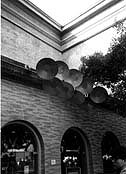Shimoda (S): Okay, let me ask you about your program, "Ears Wide Open." Could you summarize the history of your program?
Carl Stone (C): Before I moved to San Francisco, I lived in Los Angeles and there I did a program which had almost the same concept, but with a different name. The program was called "Imaginary Landscape." So when I'm talking about "Ears Wide Open," I'm also talking about "Imaginary Landscape." That program started in 1977, and basically, I made the program about contemporary music, new music from John Cage and after. I tried to present many new musics and I also had interviews with composers, so that the audience could understand a little more about their ideas. And also we had some live performances and some special projects. I tried to concentrate on many new things. My interest is in electronic and computer music, so maybe the program is sometimes a little bit more weighted toward that. But also we did things that crossover into rock, jazz, and world music.
S: Did someone ask you to be a producer for KPFA after you moved here?
C: Yes, I was kind of lucky because shortly after I moved to San Francisco, there was an opportunity to start a new program at KPFA. The beginning of "Ears Wide Open" was in 1995.
S: Your program is broadcast every Sunday from 8:00pm until 11:00pm?
C: Yes, that's right.
S: Could you tell me a little about the structure of it?
C: Ah! I try to be a little bit flexible and I don't have a formula. But basically, if I have some guest, I will first introduce them through their music and then speak to them, and then present some more music so that the audience can come to understand their ideas. But because I have a three-hour program, that means sometimes I can play really long compositions without speaking. For example, a one- or two-hour piece. It's very nice to do that, because most stations don't give you that chance. For example, I presented the entire CD that accompanied the book, Ocean of Sound by David TOOP. Xebec and you yourself are featured in the book, in fact. That was very nice to see. And the CD is also very interesting.
Ears Wide Open

